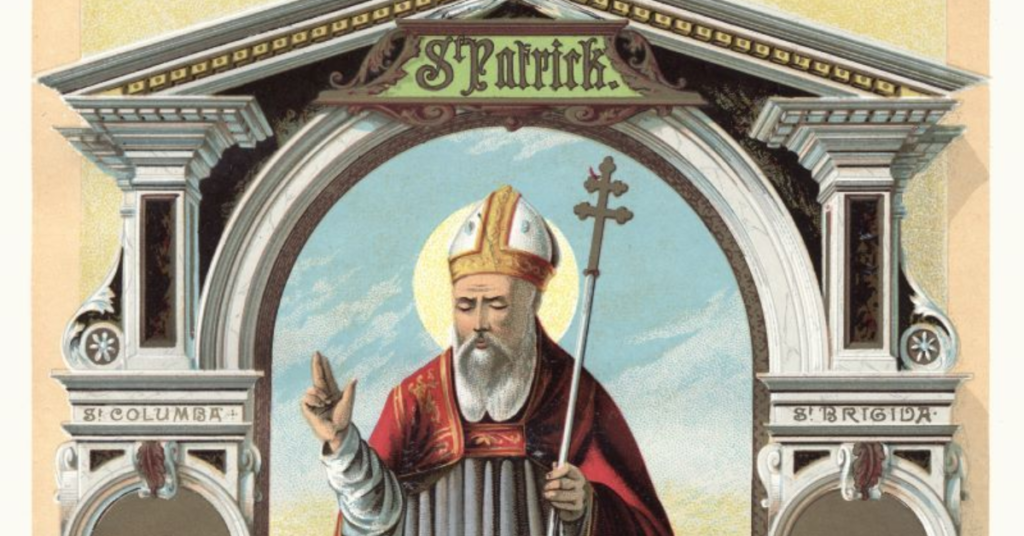Born in Roman Britain in the late 4th century, St. Patrick was kidnapped at the age of 16 and taken to Ireland as a slave. He escaped after six years but returned around 432 AD to convert the Irish to Christianity.
By the time of his death on March 17, 461 AD, he had established monasteries, churches, and schools across the country. Many stories grew up around him and made him the foremost patron saint of Ireland.

Early Life of St. Patrick
Birth and Family Background
St. Patrick was born in Roman Britain in the late 4th century AD. His father was a deacon and his grandfather was a priest in the Christian church, indicating a deeply religious family background. However, the exact location of his birth remains a topic of debate among scholars.
Kidnapping and Enslavement
Irish raiders kidnapped St. Patrick at the age of 16, dramatically changing his life. They took him to Ireland as a slave, a common practice in those turbulent times.
They put him to work as a shepherd, during which time he increasingly turned to religion for solace.
Escape and Return to Britain
After six years in captivity, St. Patrick managed to escape and make his way back to his family in Britain. His escape was guided by a dream in which a voice told him a ship would be waiting to take him home. His return home marked the end of a dark chapter in his life but set the stage for his future mission.
Spiritual Awakening and Religious Studies
Once back in Britain, St. Patrick experienced a spiritual awakening. He began to study Christianity in earnest, dedicating many years to religious studies. His studies would form the foundation of his later work in Ireland.

Circumstances of St. Patrick’s Death
Final Years: Retirement from Public Life
After years of missionary work, St. Patrick retired from public life. He chose to spend his final years in quiet solitude, dedicating his time to prayer and reflection.
Despite retiring from active missionary work, he continued to influence the spread of Christianity in Ireland through the institutions he had established.
Onset of Illness and His Last Days
As St. Patrick aged, he began to suffer from various health issues. Historical accounts suggest that he may have suffered from a particular illness during his last days. However, the exact nature of this illness remains unknown as medical knowledge during this period was limited.
Moment of Death: Accounts and Legends
“Documentation does not clearly detail the exact circumstances of St. Patrick’s death. Many believe he died peacefully in his sleep. Tradition marks his death date as March 17, 461 AD, now celebrated as St. Patrick’s Day However, some sources suggest that this date might not be accurate.
Burial and Canonization: The Path to Sainthood
After his death, St. Patrick was quickly canonized by the local church. His remains were wrapped in a shroud and buried at a secret location. Over time, several places have claimed to be his burial site, but the exact location remains a mystery.
Historical Records and Accounts of His Death: Fact vs Fiction
Over the centuries, numerous legends have sprung up around St. Patrick’s death. While these stories offer fascinating insights into how St. Patrick was remembered, they often blur the line between fact and fiction.
It’s important to approach these accounts critically, distinguishing historical facts from pious legends.
Enduring Mystery of His Death
The mystery surrounding St. Patrick’s death adds to his intriguing legacy. Despite the lack of concrete historical evidence, the stories and legends about his death continue to captivate people’s imagination and inspire scholarly research.
Related Posts
- How Saint Patrick’s day is Celebrated in Ireland
- Tips To Celebrate Saint Patrick’s Day In January 2024
- Saint Patrick’s Day in Popular Culture
Conclusion
The life and death of St. Patrick, the patron saint of Ireland, continue to fascinate people around the world. His journey from a slave to a missionary who played a pivotal role in converting Ireland to Christianity is a testament to his enduring faith and resilience.
The mystery surrounding his death adds an intriguing layer to his already compelling story. While we may never know the exact circumstances of his death, the legacy he left behind continues to influence Irish Christianity and culture to this day.
FAQS
St. Patrick is known for converting Ireland to Christianity. He established many churches and schools across the country.
St. Patrick’s Day celebrated on March 17th, is a cultural and religious holiday commemorating the death of St. Patrick, the patron saint of Ireland.
One of the legends associated with St. Patrick is that he banished all snakes from Ireland. However, this is likely a metaphor for his efforts to convert the Irish people to Christianity.
The exact location of St. Patrick’s burial site remains a mystery. Several places have claimed to be his burial site, but none have been confirmed.
St. Patrick’s legacy is evident in the widespread celebration of St. Patrick’s Day and the continued influence of his teachings in Irish Christianity. His life and death continue to be a subject of historical and religious study.

